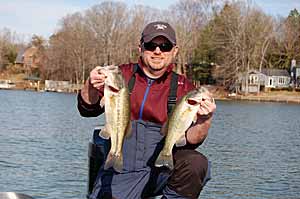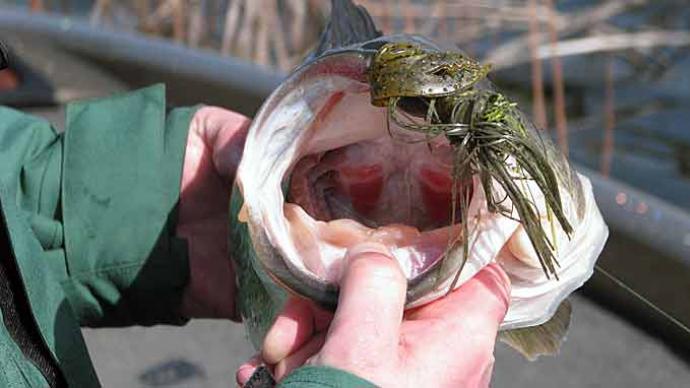
The winter months are considered one of the most challenging times for bass fishing. Bass activity slows down a great deal. Many anglers put up their gear and wait until next year for higher temperatures. They believe that bass stop feeding. Yes, there may be days when bass may not feed to preserve energy to be able to endure the cold. But remember, bass must eat to survive.
A bass knows that he must eat even though he may not want to use the energy to hunt down prey. A bass will certainly not chase a lure or baitfish as far or as hard as he would in the spring, summer, and fall. But sooner or later, a bass will bite. The trick is to be persistent. When a bass sees your lure come by a couple of times and realizes that it's not going to have to use a lot of energy to strike, he might decide to come out and eat it. Throw your lure in the same spot three, four, or even five to six times.
Two lures that I use in the winter are plastic worms and jigs. I use these because they are generally slow-moving lures. For plastic worms (rigged weedless with a bullet weight), I throw them by rocks, stumps, and weed beds in shallower water and retrieve them with a slow, drag and twitch motion. I drag it slowly with my rod tip sideways pointed at the water or the 2:00 position going to the noon position. Then I reel up the slack and twitch it with my rod tip quickly, but my rod tip only moves about 2 inches. This gives the lure a little more life.
Remember not ever to go too fast. The key is to use a slow presentation, and some of those fish will bite. You must have confidence the fish are there and then be deliberate without too much movement. Your presentation has to slow down. Everything is quicker and faster during the summer, but not in the winter. Anything too erratic and fast will seem unnatural to the bass. They like everything a little slower, a little time to get it, and not too much vibration. That's what works, slow, methodical presentations. One cast might last one to two minutes.
Use the smallest weight you can get away with given wind conditions and the thickness of the brush. Usually, a 1/8-ounce works best. Once again, dissect the brush. Say I had one overhanging bush or one piece of structure; it might take me fifteen minutes to fish that one spot. You should cast over different limbs, in different pockets, holes, shake the bait, and work it; and most of the time, the bites will come on the drop.
For jigs, key on the same structure. Slowly raise your rod tip and drop it. Now and then, twitching the jig. Sometimes bass will just up and take off with your jig, and you'll never feel him hit. If one retrieve doesn't work after a while, try to find another one that works.
A good idea is to fish during the afternoon. The temperature will be at its highest during that time. Look for areas with southern exposure. Patience and persistence are the keys to catching shallow fish in the wintertime. The main thing to remember is never to quit too early. You may just be missing some good fishing. And remember, even if you don't catch any fish, try to enjoy the whole experience.




